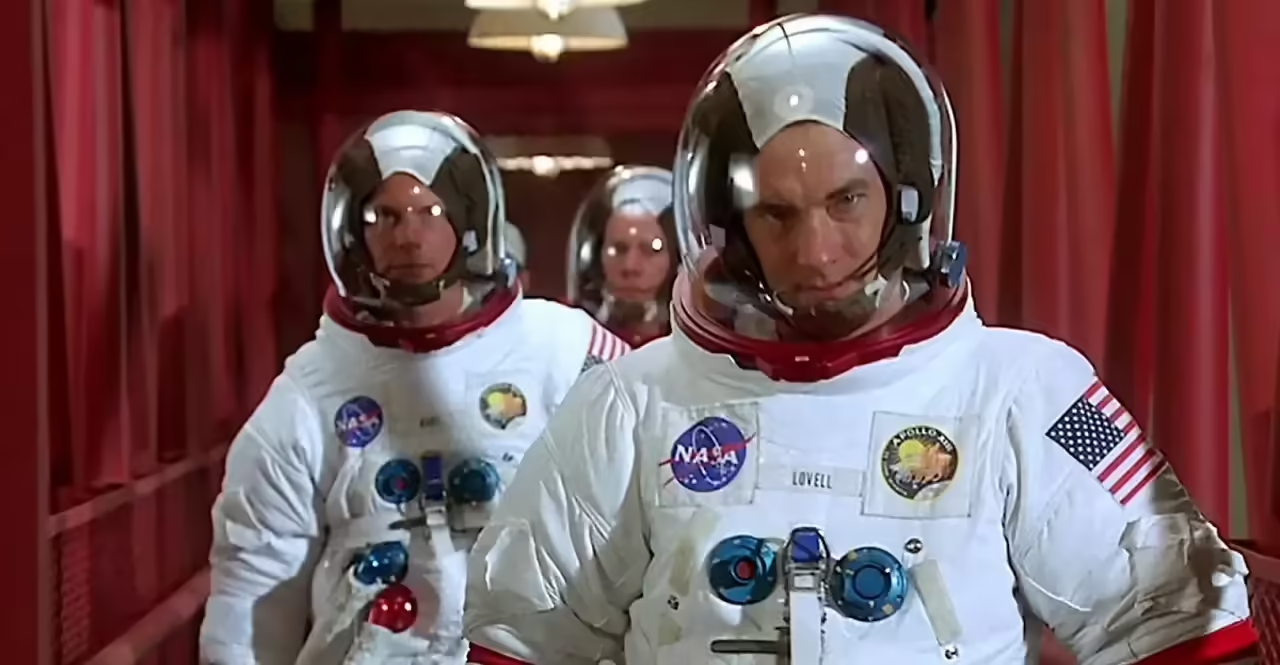
The story of Apollo 13 is one that resonates with audiences around the world, not only for its gripping narrative but also for its historical significance in the world of cinema. Directed by Ron Howard, “Apollo 13” is a remarkable film that brings to life the true story of the NASA mission of the same name. In this article, we’ll provide an introduction to the film, exploring its plot, cast, and its enduring impact on the history of cinema.
The Plot
“Apollo 13,” released in 1995, is based on the real-life events of the ill-fated Apollo 13 mission, which was intended to be the third mission to land astronauts on the moon. The film takes us back to April 11, 1970, when astronauts Jim Lovell (played by Tom Hanks), Fred Haise (played by Bill Paxton), and Jack Swigert (played by Kevin Bacon) embark on their journey to the moon. However, while en route to their lunar destination, an oxygen tank on their spacecraft, Odyssey, explodes, putting the lives of the crew in jeopardy.
The film follows the astronauts’ struggle for survival and the heroic efforts of NASA’s ground control team to bring them safely back to Earth. It’s a gripping tale of human ingenuity, resourcefulness, and determination in the face of seemingly insurmountable odds.
The Cast
One of the film’s standout features is its stellar cast. Tom Hanks, who plays Jim Lovell, delivers a powerful performance that underscores the leadership and resolve of the mission’s commander. Bill Paxton and Kevin Bacon also give compelling portrayals of their respective crew members. The film’s supporting cast, including Ed Harris, Kathleen Quinlan, and Gary Sinise, adds depth to the narrative, making “Apollo 13” a truly ensemble piece.
Cinematic Significance
“Apollo 13” is not just a gripping adventure in space but also a significant milestone in cinematic history. Here’s why:
Historical Accuracy: The film’s dedication to accuracy in portraying the actual events of the Apollo 13 mission is commendable. It was made with the cooperation of NASA and used detailed research, including transcripts and footage from the mission, to recreate the events as faithfully as possible.
Technological Realism: “Apollo 13” is known for its realistic portrayal of space travel. The filmmakers ingeniously used physical effects and models to create the weightless environment, which adds to the film’s authenticity.
Human Drama: The film masterfully balances the technical aspects of the mission with the human drama unfolding in space and on Earth. It captures the tension, uncertainty, and the human spirit of never giving up, which is universally relatable.
Critical Acclaim: “Apollo 13” received critical acclaim and was nominated for nine Academy Awards, including Best Picture. It won Oscars for Best Film Editing and Best Sound.
The Cast and Characters of Apollo 13: Analyzing Performances and Real-Life Parallels
In the 1995 cinematic masterpiece, “Apollo 13,” the impeccable cast brings to life the real-life heroes of NASA’s ill-fated mission. Directed by Ron Howard, the film not only pays homage to the brave astronauts but also honors their real-life counterparts. In this section, we will delve into the portrayals of the main actors and how they relate to the actual individuals they play.
Tom Hanks as Jim Lovell
Tom Hanks takes on the role of Jim Lovell, the mission commander of Apollo 13. Hanks’ performance is a testament to his skill as an actor. He captures the essence of Jim Lovell’s leadership, determination, and calm under pressure. Lovell was known for his ability to keep his crew focused and optimistic during the crisis, and Hanks does an outstanding job of embodying these qualities.
Bill Paxton as Fred Haise
Bill Paxton portrays Fred Haise, the lunar module pilot. Haise’s character exhibits a mix of frustration, humor, and professionalism. Paxton’s performance is both convincing and heartfelt. His portrayal emphasizes Haise’s adaptability in the face of adversity.
Kevin Bacon as Jack Swigert
Kevin Bacon takes on the role of Jack Swigert, the command module pilot. Swigert was a last-minute addition to the Apollo 13 crew, and Bacon’s performance captures his initial nervousness and eventual competence under pressure. Bacon brings depth to Swigert’s character, showcasing his growth throughout the mission.
Ed Harris as Gene Kranz
Ed Harris plays Gene Kranz, the legendary NASA Flight Director. Harris’ portrayal of Kranz is nothing short of remarkable. He perfectly embodies Kranz’s no-nonsense leadership style and the unwavering commitment of the NASA ground control team. The character’s iconic white vest, which Kranz wore during the mission, became a symbol of dedication and control.
Kathleen Quinlan as Marilyn Lovell
Kathleen Quinlan portrays Marilyn Lovell, Jim Lovell’s wife. Her performance highlights the emotional turmoil experienced by the families of the astronauts during the mission. Quinlan’s portrayal of Marilyn is both touching and poignant, conveying the fear and resilience of the loved ones left behind on Earth.
Gary Sinise as Ken Mattingly
Gary Sinise takes on the role of Ken Mattingly, the original command module pilot who was replaced by Jack Swigert shortly before the mission. Sinise captures Mattingly’s professionalism, dedication, and the emotional complexity of being grounded due to the risk of contracting measles.
Real-Life Parallels
The actors’ performances in “Apollo 13” align closely with the real-life personalities of the individuals they portray. The film’s dedication to historical accuracy extends to the characterizations, and this commitment is one of the reasons the movie has left such a lasting impact. The audience gains a profound appreciation for the astronauts and the individuals at NASA who worked tirelessly to ensure the crew’s safe return to Earth.
The Apollo 13 Mission: Real-Life Details and Historical Context
“Apollo 13,” the 1995 cinematic portrayal of NASA’s Apollo 13 mission, is a gripping story of human determination and innovation set against the backdrop of the turbulent 1970s. In this section, we will explore the actual Apollo 13 mission, delving into the historical context and key details that inspired the film.
The Apollo 13 Mission: Mission Objectives
The Apollo 13 mission, officially designated as Apollo Lunar Module-7 (LM-7), was the seventh manned mission in NASA’s Apollo space program. Its primary objective was to become the third mission to land astronauts on the moon, specifically in the Fra Mauro region. The astronauts were to explore the lunar surface, conduct experiments, and return to Earth with valuable data.
The Crew: The Apollo 13 crew consisted of three astronauts
Jim Lovell (Commander)
Fred Haise (Lunar Module Pilot)
Ken Mattingly (Command Module Pilot) – Mattingly was replaced by Jack Swigert shortly before the mission due to concerns about Mattingly’s exposure to the measles.
The Ill-Fated Journey
On April 11, 1970, Apollo 13 lifted off from Kennedy Space Center in Florida. However, just over 55 hours into the mission, disaster struck. An oxygen tank in the service module of the spacecraft exploded, causing a cascade of critical system failures.
The explosion not only jeopardized the mission’s primary objectives but also threatened the lives of the astronauts. The crew and the ground control team at NASA faced the daunting challenge of improvising a safe return to Earth, despite the limited resources and life support systems available.
The Historical Context
The 1970s were a pivotal era in space exploration and U.S. history. Several historical factors and events are essential to understanding the context of the Apollo 13 mission:
Space Race: The Apollo program was part of the Cold War-era Space Race between the United States and the Soviet Union. Each nation sought to demonstrate its technological and scientific prowess, and Apollo 13 was one of the missions intended to showcase American capabilities.
Public Interest: The Apollo program captured the imagination of the world, and public interest was high. However, by the time of Apollo 13, moon missions had become routine, and media coverage had waned. The mission’s unexpected crisis reignited public interest and sympathy.
Vietnam War: The 1970s were marked by the ongoing Vietnam War, civil unrest, and political turmoil. The Apollo program provided a unifying distraction and symbol of American achievement during a challenging period in U.S. history.
Technological Challenges: The era presented immense technological challenges. Apollo 13’s successful return to Earth highlighted the innovative spirit of NASA and the nation.
The Science Behind the Film: Exploring Scientific Accuracy and Special Effects in Apollo 13
“Apollo 13,” directed by Ron Howard, is renowned for its commitment to scientific accuracy, which brings the harrowing space mission to life. In this section, we will delve into the scientific precision and the impressive special effects that made the film a triumph of realism.
Scientific Accuracy: Spacecraft Design
One of the film’s notable achievements is its meticulous replication of the Apollo spacecraft. The command module, service module, and lunar module were recreated with remarkable accuracy. Every button, switch, and detail was faithfully reproduced to provide an authentic portrayal of the spacecraft’s interior.
Weightlessness
To create the sensation of weightlessness, the filmmakers employed innovative techniques. They built sets inside NASA’s KC-135 “vomit comet,” a specialized aircraft that creates brief periods of microgravity. This allowed the actors to experience weightlessness during the filming. The result is a convincing depiction of astronauts floating in space.
Communication
The film captures the complexities of communication in space. It accurately depicts the use of radio frequencies, mission transcripts, and the distinctive “Houston, we have a problem” moment, which is nearly verbatim from the actual mission.
Realistic Reproduction
“Apollo 13” used transcripts, reports, and resources from NASA to recreate events with meticulous detail. This commitment to historical accuracy extends to the depiction of the spacecraft’s systems, navigation, and astronaut procedures.
Special Effects: The Weightless Environment
To simulate the weightlessness of space, the filmmakers utilized practical effects, including wires and other rigging techniques. Careful planning and execution allowed the actors to move convincingly in a zero-gravity environment. These practical effects added a level of authenticity to the film.
Miniature Models
The film also relied on intricate miniature models of the spacecraft. These models were used for exterior shots and reentries into the Earth’s atmosphere. The miniatures were meticulously crafted and filmed to provide stunning visuals that closely resembled real space missions.
High-Speed Photography
The movie employed high-speed photography to capture the intense moments of the spacecraft’s launch, docking, and other critical scenes. This technique allowed for a more dramatic and realistic portrayal of the mission’s pivotal moments.
The Impact
The scientific accuracy and the effective use of special effects in “Apollo 13” contributed to the film’s critical acclaim and its status as a milestone in space cinema. It offered a window into the rigors and perils of space travel while demonstrating the power of human ingenuity and teamwork.







